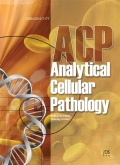Authors: Wang, Lin | Huang, Juxiang | Jiang, Minghu | Diao, Haizhen | Zhou, Huilei | Li, Xiaohe | Chen, Qingchun | Jiang, Zhenfu | Feng, Haitao | Wolfl, Stefan
Article Type:
Research Article
Abstract:
BACKGROUND: To understand cartilage oligomeric matrix protein (COMP) mechanism network from human normal adjacent tissues to lung adenocarcinoma. METHODS: COMP complete different activated (all no positive correlation, Pearson CC < 0.25) and uncomplete (partly no positive correlation except COMP, Pearson CC < 0.25) network were identified in higher lung adenocarcinoma compared with lower human normal adjacent tissues from the corresponding COMP-stimulated (≥0.25) or inhibited (Pearson CC ≤ -0.25) overlapping molecules of Pearson correlation coefficient (CC) and GRNInfer, respectively. COMP complete different activated and inhibited (all no positive correlation, Pearson CC < 0.25) mechanisms networks of higher lung adenocarcinoma and lower
…human normal adjacent tissues were constructed by integration of Pearson CC, GRNInfer and GO. As visualized by integration of GO, KEGG, GenMAPP, BioCarta and Disease, we deduced COMP complete different activated and inhibited network in higher lung adenocarcinoma and lower human normal adjacent tissues. RESULTS: As visualized by GO, KEGG, GenMAPP, BioCarta and disease database integration, we proposed mainly that the mechanism and function of COMP complete different activated network in higher lung adenocarcinoma was involved in COMP activation with matrix-localized insulin-like factor coupling carboxypeptidase to metallopeptidase-induced proteolysis, whereas the corresponding inhibited network in lower human normal adjacent tissues participated in COMP inhibition with nucleus-localized vasculogenesis, B and T cell differentiation and neural endocrine factors coupling pyrophosphatase-mediated proteolysis. However, COMP complete different inhibited network in higher lung adenocarcinoma included COMP inhibition with nucleus-localized chromatin maintenance, licensing and assembly factors coupling phosphatase-inhibitor to cytokinesis regulators-mediated cell differentiation, whereas the corresponding activated network in lower human normal adjacent tissues contained COMP activation with cytolplasm-localized translation elongation factor coupling fucosyltransferase to ubiquitin-protein ligase-induced cell differentiation. CONCLUSION: COMP different networks were verified not only by complete and uncomplete COMP activated or inhibited networks within human normal adjacent tissues or lung adenocarcinoma, but also by COMP activated and inhibited network between human normal adjacent tissues and lung adenocarcinoma.
Show more
Keywords: Cartilage oligomeric matrix protein (COMP), cell differentiation to proteolysis mechanism networks, from human normal adjacent tissues to lung adenocarcinoma
DOI: 10.3233/ACP-130084
Citation: Analytical Cellular Pathology,
vol. 36, no. 3-4, pp. 93-105, 2013
Price: EUR 27.50





